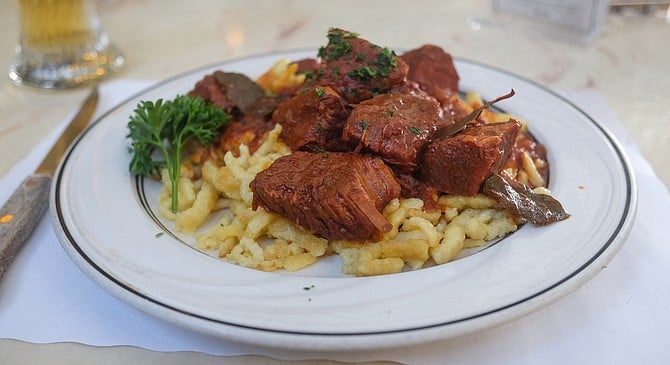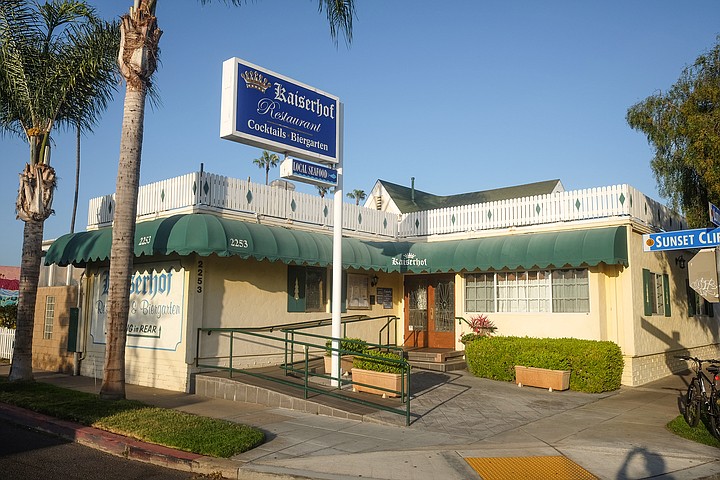 Facebook
Facebook
 X
X
 Instagram
Instagram
 TikTok
TikTok
 Youtube
Youtube

When a friend recently sought tips on local eateries he could take his children to learn about the food of foreign cultures, one of the first that came to mind was Kaiserhof. For over 30 years, the Ocean Beach restaurant and biergarten has employed dirndl-wearing waitresses to dish out authentically German dishes (and beers). In recommending it, I realized it had been nearly a year since my last visit, so I plotted a Friday evening return.

Inside its polished, white linened dining room, 20- to 30-dollar entrees highlight the classics of Deutschland fare, such as wiener schnitzel, sauerbraten, and several types of würste. It looks nice in there, but I’ve always skipped it in favor of the biergarten, really a covered patio offering televised sports and pitchers of crisp, imported lagers. Not only do I prefer the more casual atmosphere, but there’s a biergarten menu offering smaller portions of select entrees for half the price.
It’s a place I’ve enjoyed house-made bratwurst and kasespatzle (a.k.a. German macaroni and cheese), and it’s easily the top spot in town to watch Germany play in the World Cup. Because when Germans in attendance belt out traditional Fußballmannschaft songs each time their team scores a goal, the confluence of food and culture offers a small, joyful window into Bavarian life.
Admittedly, I didn’t bring joy with me to that early Friday dinner, but gloom. I’d awakened that morning to the news Anthony Bourdain had taken his own life, and my day had been filled with sorrowful remembrance of an incredible storyteller — part philosopher, poet, and journalist — who’d stoked my interest for the food of the world, including Germany. Including the United States, and for that matter, my own kitchen.
Much of the morning had been spent commiserating with fellow foodies and food writers, people who, like me, had spent hours devouring his books and TV shows. Who’d scheduled vacation days around eating food Bourdain had encouraged we try, in places he’d encouraged us to see.
With a tall glass of beer in hand, I toasted the man, over an order of goulash. It's really a Hungarian dish, but since we don't have a dedicated Hungarian restaurant, I've come here to find it. Only a week prior, I’d dialed up the Budapest episode of Bourdain’s CNN travel show Parts Unknown. As was often the case, by time the episode ended I found myself pricing travel itineraries to visit Budapest, primed to marvel at its architecture and gorge on paprika-laden dishes, like goulash.
I didn’t book that trip. I might someday, but know that I won’t see most of the places Bourdain shared. My best bet is to seek out restaurants like Kaiserhof, which offer versions of dishes covered on his shows. For $14.50, Kaiserhof served me a wonderfully simple plate of goulash: tender, tomato- and onion-stewed chunks of beef, loaded with paprika and bay leaves, served over chewy, handmade spatzle noodles.


When a friend recently sought tips on local eateries he could take his children to learn about the food of foreign cultures, one of the first that came to mind was Kaiserhof. For over 30 years, the Ocean Beach restaurant and biergarten has employed dirndl-wearing waitresses to dish out authentically German dishes (and beers). In recommending it, I realized it had been nearly a year since my last visit, so I plotted a Friday evening return.

Inside its polished, white linened dining room, 20- to 30-dollar entrees highlight the classics of Deutschland fare, such as wiener schnitzel, sauerbraten, and several types of würste. It looks nice in there, but I’ve always skipped it in favor of the biergarten, really a covered patio offering televised sports and pitchers of crisp, imported lagers. Not only do I prefer the more casual atmosphere, but there’s a biergarten menu offering smaller portions of select entrees for half the price.
It’s a place I’ve enjoyed house-made bratwurst and kasespatzle (a.k.a. German macaroni and cheese), and it’s easily the top spot in town to watch Germany play in the World Cup. Because when Germans in attendance belt out traditional Fußballmannschaft songs each time their team scores a goal, the confluence of food and culture offers a small, joyful window into Bavarian life.
Admittedly, I didn’t bring joy with me to that early Friday dinner, but gloom. I’d awakened that morning to the news Anthony Bourdain had taken his own life, and my day had been filled with sorrowful remembrance of an incredible storyteller — part philosopher, poet, and journalist — who’d stoked my interest for the food of the world, including Germany. Including the United States, and for that matter, my own kitchen.
Much of the morning had been spent commiserating with fellow foodies and food writers, people who, like me, had spent hours devouring his books and TV shows. Who’d scheduled vacation days around eating food Bourdain had encouraged we try, in places he’d encouraged us to see.
With a tall glass of beer in hand, I toasted the man, over an order of goulash. It's really a Hungarian dish, but since we don't have a dedicated Hungarian restaurant, I've come here to find it. Only a week prior, I’d dialed up the Budapest episode of Bourdain’s CNN travel show Parts Unknown. As was often the case, by time the episode ended I found myself pricing travel itineraries to visit Budapest, primed to marvel at its architecture and gorge on paprika-laden dishes, like goulash.
I didn’t book that trip. I might someday, but know that I won’t see most of the places Bourdain shared. My best bet is to seek out restaurants like Kaiserhof, which offer versions of dishes covered on his shows. For $14.50, Kaiserhof served me a wonderfully simple plate of goulash: tender, tomato- and onion-stewed chunks of beef, loaded with paprika and bay leaves, served over chewy, handmade spatzle noodles.
Comments